Father-Child RTP and Children's Cognitive Outcomes
41 Pages12005 Words74 Views
Added on 2023-01-19
About This Document
This study examines the relationship between father-child Rough and Tumble Play (RTP) and children's cognitive outcomes. It uses both quantitative and qualitative measures of RTP interactions to assess the impact on child cognitive development. The findings suggest that increasing frequency and quality of RTP, as well as being a female child, predict better working memory outcomes. However, caution should be exercised due to the small sample size.
Father-Child RTP and Children's Cognitive Outcomes
Added on 2023-01-19
ShareRelated Documents
Abstract
Numerous studies show that fathers’ involvement and play activities have a unique
influence on child cognitive outcomes, however the effect of father-child Rough and
Tumble Play (RTP) on cognitive outcomes has been paid scant attention. In addition,
existing father-child RTP studies predominantly only use either quantitative, or
qualitative measure of RTP. Thus, this study used both quantitative and qualitative
measures of father-child RTP interactions, to examine whether RTP is related to
children’s cognitive outcomes. This study involved 30 father (27 - 49 years old) and
child (4 - 7 years old) dyads in Australia. The frequency of RTP, quality of RTP and
child cognitive outcomes were measured using the Parent Involvement Scale (PIS),
RTP-Quality scale (RTP-Q) and Wechsler Preschool and Primary Scale of Intelligence
– Fourth Edition Australian and New Zealand Standardised Edition (WPPSI-IV). The
Multiple Regression Analyses indicated that increasing frequency and quality of RTP,
as well as being a female child, predicted better working memory outcomes for the
child. The findings support that father-child RTP has a positive role in child cognitive
outcomes, however, extra care should be taken when drawing generalisations from these
results due to the small sample size.
Numerous studies show that fathers’ involvement and play activities have a unique
influence on child cognitive outcomes, however the effect of father-child Rough and
Tumble Play (RTP) on cognitive outcomes has been paid scant attention. In addition,
existing father-child RTP studies predominantly only use either quantitative, or
qualitative measure of RTP. Thus, this study used both quantitative and qualitative
measures of father-child RTP interactions, to examine whether RTP is related to
children’s cognitive outcomes. This study involved 30 father (27 - 49 years old) and
child (4 - 7 years old) dyads in Australia. The frequency of RTP, quality of RTP and
child cognitive outcomes were measured using the Parent Involvement Scale (PIS),
RTP-Quality scale (RTP-Q) and Wechsler Preschool and Primary Scale of Intelligence
– Fourth Edition Australian and New Zealand Standardised Edition (WPPSI-IV). The
Multiple Regression Analyses indicated that increasing frequency and quality of RTP,
as well as being a female child, predicted better working memory outcomes for the
child. The findings support that father-child RTP has a positive role in child cognitive
outcomes, however, extra care should be taken when drawing generalisations from these
results due to the small sample size.
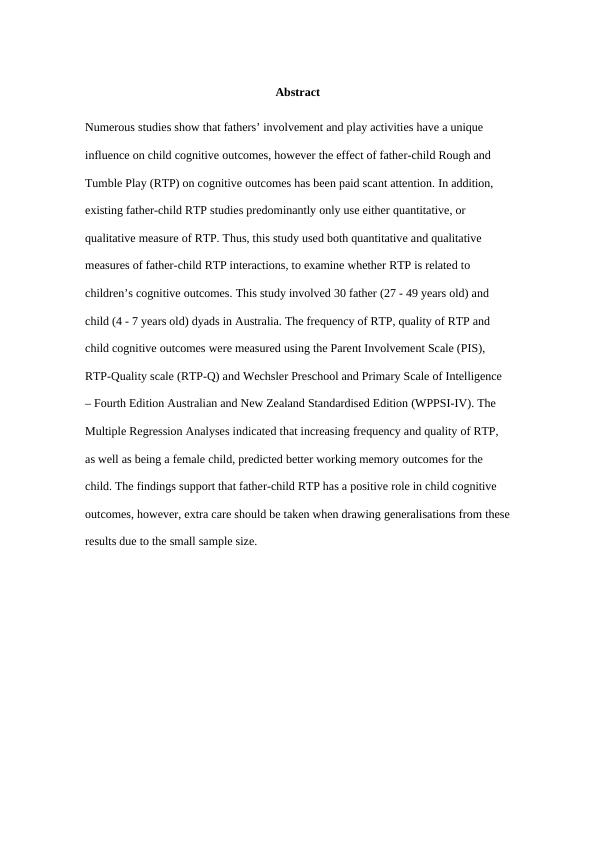
Traditionally, a father’s involvement was as a role of economic provider in the family
(Lamb, 2004). However, according to Gauthier, Smeeding and Furstenberg (2004), this
has shifted with fathers now being more actively involved in the rearing of their
children than in the past decades. This change has been explained by the transformation
of the mother’s role from primary child caregiver to becoming part of the labour force
and ideologies of good parenting (Abella, 2017; Bianchi, 2000). Through this shift of
paternal involvement, the father is not only considered as a breadwinner, but also as a
parent who is expected to engage in a wide range of tasks and activities related to the
upbringing of their children (Barbeta-Viñas, & Cano, 2017).
Parenting time of fathers has increased; however, research seems to indicate that it is
still the mothers who are more involved in the caring of their children, with exception of
carrying out play activities. According to an empirical study conducted by Russell and
Russell (1987), mothers are more engaged with their children and more involved a
range of caregiving activities (e.g., child-need tasks, school work). In contrast, fathers
are more involved with their children in play activities (e.g., Rough and Tumble Play
(RTP), outdoor games).
Physical play, such as RTP, has been identified as common in father and child
dyads, but not as typical in mother and child play (MacDonald & Parke, 1986; Russell
& Russell, 1987). RTP can be defined as a physical activity play that includes vigorous
and aggressive behaviours such as grappling, tumbling and wrestling within a playful
context (Flanders, Leo, Paquette, Pihl, & Séguin, 2009; Pellegrini, & Smith, 1998).
Only a few RTP studies have been carried out with respect to fathers and
children and it has been identified as an under researched field for investigating in child
developmental outcomes (Tannock, 2011). Lines of father and child RTP studies on
(Lamb, 2004). However, according to Gauthier, Smeeding and Furstenberg (2004), this
has shifted with fathers now being more actively involved in the rearing of their
children than in the past decades. This change has been explained by the transformation
of the mother’s role from primary child caregiver to becoming part of the labour force
and ideologies of good parenting (Abella, 2017; Bianchi, 2000). Through this shift of
paternal involvement, the father is not only considered as a breadwinner, but also as a
parent who is expected to engage in a wide range of tasks and activities related to the
upbringing of their children (Barbeta-Viñas, & Cano, 2017).
Parenting time of fathers has increased; however, research seems to indicate that it is
still the mothers who are more involved in the caring of their children, with exception of
carrying out play activities. According to an empirical study conducted by Russell and
Russell (1987), mothers are more engaged with their children and more involved a
range of caregiving activities (e.g., child-need tasks, school work). In contrast, fathers
are more involved with their children in play activities (e.g., Rough and Tumble Play
(RTP), outdoor games).
Physical play, such as RTP, has been identified as common in father and child
dyads, but not as typical in mother and child play (MacDonald & Parke, 1986; Russell
& Russell, 1987). RTP can be defined as a physical activity play that includes vigorous
and aggressive behaviours such as grappling, tumbling and wrestling within a playful
context (Flanders, Leo, Paquette, Pihl, & Séguin, 2009; Pellegrini, & Smith, 1998).
Only a few RTP studies have been carried out with respect to fathers and
children and it has been identified as an under researched field for investigating in child
developmental outcomes (Tannock, 2011). Lines of father and child RTP studies on
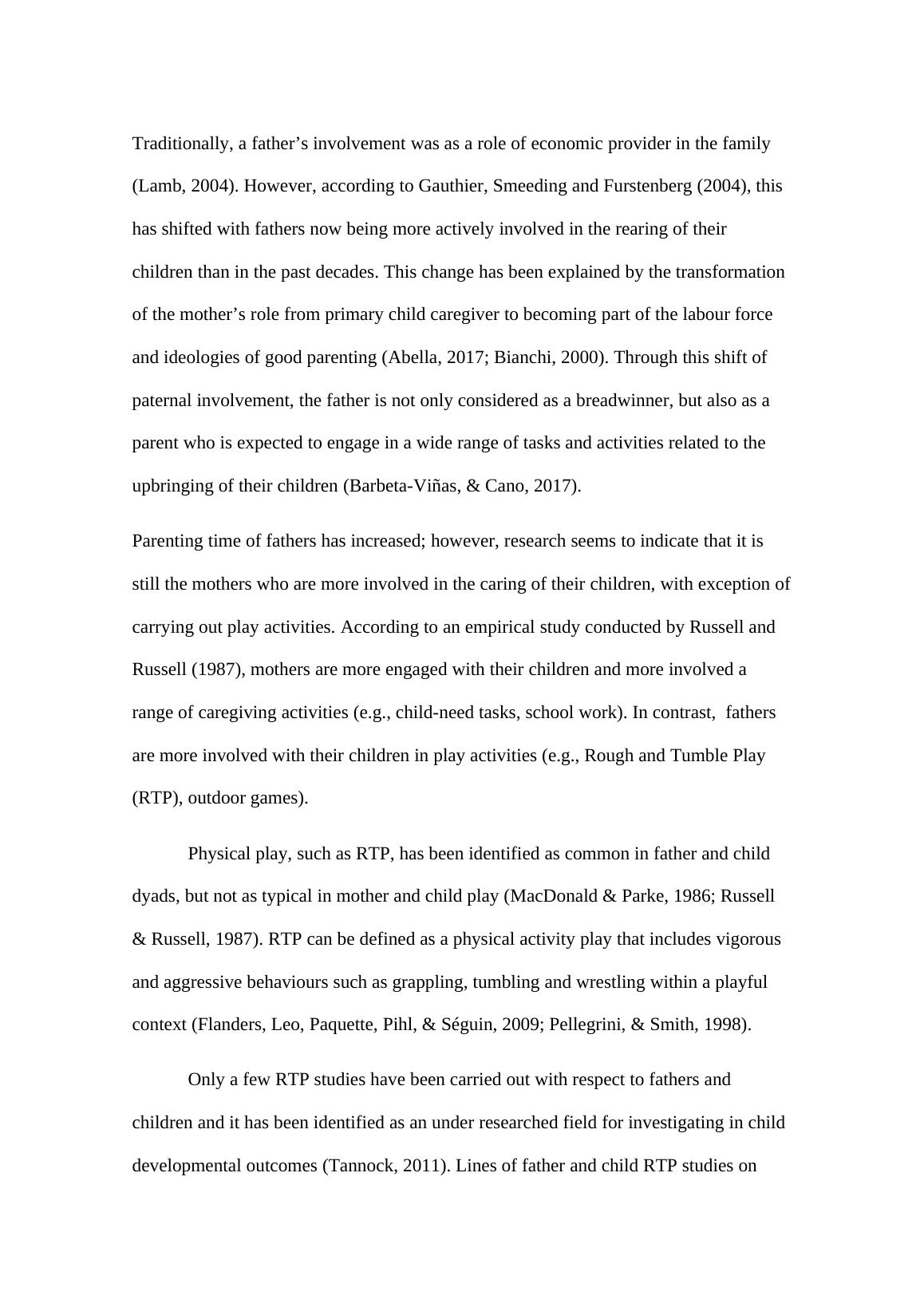
child developmental outcomes show that father and child RTP has been positively
associated with improving children’s social competence, reducing their aggression and
enhancing their self-confidence (e.g., MacDonald, & Parke, 1984; Paquette,
Carbonneau, Dubeau, Bigras, & Tremblay, 2003). However, the research has been
focused on the relationship between RTP and children’s emotional and behavioural
outcomes, more so than other potential child developmental outcomes.
Many studies have pointed towards father involvement along with father play
influencing child cognitive development. According to Ginsburg (2007), play activities
have been introduced as a significant contributor to child development, and is
introduced as an important part of parenting which can promote children’s cognitive
skills. However, the relationship between father and child RTP and child cognitive
outcomes is yet to be investigated.
In order to understand the relationship between father and child RTP and child
cognitive outcomes both quantitative and qualitative measures of father and child RTP
should be considered. However, the majority of research into father and child RTP as
well as the studies noted above have assessed father and child RTP under a quantitative
framework (e.g., the frequency of RTP; see St George, & Freeman, 2017 for a review).
Additionally, although a qualitative framework has been considered in some research,
the majority of researchers have only paid attention to single attributes of quality in
RTP (e.g., father’s sensitivity and father’s dominance). With respect to the impact of
comprehensive qualitative frame within father and child RTP has been scant, play
interaction as father and child interaction should be assessed by global quality of RTP
and quantitative frame as the various dimensions of approaches.
associated with improving children’s social competence, reducing their aggression and
enhancing their self-confidence (e.g., MacDonald, & Parke, 1984; Paquette,
Carbonneau, Dubeau, Bigras, & Tremblay, 2003). However, the research has been
focused on the relationship between RTP and children’s emotional and behavioural
outcomes, more so than other potential child developmental outcomes.
Many studies have pointed towards father involvement along with father play
influencing child cognitive development. According to Ginsburg (2007), play activities
have been introduced as a significant contributor to child development, and is
introduced as an important part of parenting which can promote children’s cognitive
skills. However, the relationship between father and child RTP and child cognitive
outcomes is yet to be investigated.
In order to understand the relationship between father and child RTP and child
cognitive outcomes both quantitative and qualitative measures of father and child RTP
should be considered. However, the majority of research into father and child RTP as
well as the studies noted above have assessed father and child RTP under a quantitative
framework (e.g., the frequency of RTP; see St George, & Freeman, 2017 for a review).
Additionally, although a qualitative framework has been considered in some research,
the majority of researchers have only paid attention to single attributes of quality in
RTP (e.g., father’s sensitivity and father’s dominance). With respect to the impact of
comprehensive qualitative frame within father and child RTP has been scant, play
interaction as father and child interaction should be assessed by global quality of RTP
and quantitative frame as the various dimensions of approaches.
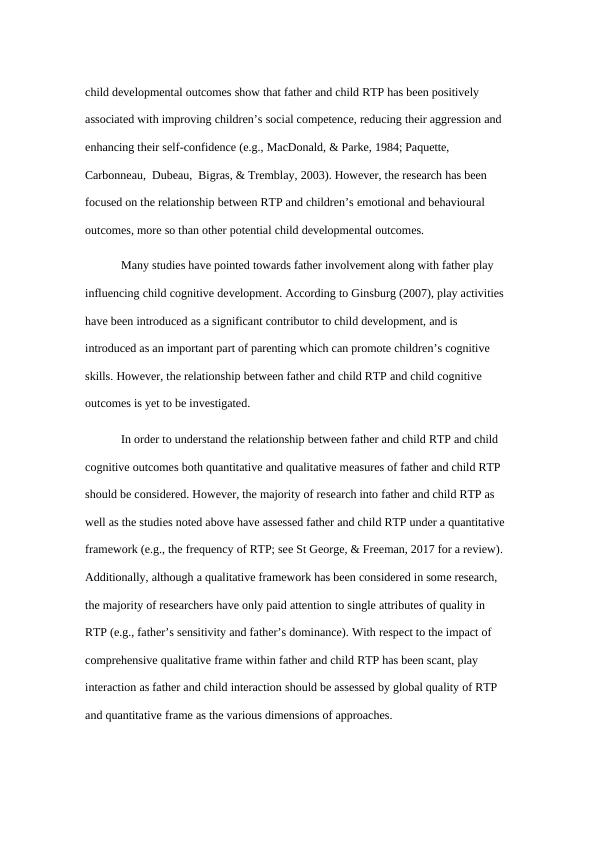
Additionally, and interestingly, the gender of the child seems to be a significant
factor when evaluating father and child RTP. Research suggests that RTP occurs more
frequently in father and son dyads than in father and daughter dyads (e.g., O’Leary, &
Parker, 2009; Paquette & Dumont, 2013; Paquette et al., 2003). This shows that there is
child gender difference in father and child RTP. Researchers need to consider the
gender of child may play role as a potential significant factor when examining the
relationship between father and child RTP and child cognitive outcomes.
This thesis will examine the relationship between father-child RTP children’s
developmental outcomes with in-depth empirical literature review. It will then consider
the different ways that RTP has been measured and will discuss the consideration of the
gender of the child when studying cognitive outcomes.
Father-Child RTP and Children's Developmental Outcomes
Studies have suggested that play activities are more central to father’s parenting style
than mother’s parenting style. Researchers have demonstrated that the largest proportion
of time fathers spend interacting with their children is spent engaging in play activities
(e.g., playing games, RTP) whereas mothers spend significantly more time with their
children fulfilling functional and work-related activities (e.g., bathing and feeding child,
school work; McBride & Mills, 1993; Russell & Russell, 1987). This father and child
interaction play has been described as active, physical, vigorous or risky, encouraging a
child to explore and learning their limits within playful context (Fletcher, May, George,
Morgan, & Lubans, 2011; Natasha & Lori, 2017). This play known as ‘Rough and
Tumble Play’ (RTP) which is playful, unstructured, competitive and wrestle-style play
including wrestling, chasing, climbing and falling with playful context (Colwell &
Lindsey, 2005; Fletcher et al., 2011; Pellis, & Pellis, 2007; Tannock, 2011).
factor when evaluating father and child RTP. Research suggests that RTP occurs more
frequently in father and son dyads than in father and daughter dyads (e.g., O’Leary, &
Parker, 2009; Paquette & Dumont, 2013; Paquette et al., 2003). This shows that there is
child gender difference in father and child RTP. Researchers need to consider the
gender of child may play role as a potential significant factor when examining the
relationship between father and child RTP and child cognitive outcomes.
This thesis will examine the relationship between father-child RTP children’s
developmental outcomes with in-depth empirical literature review. It will then consider
the different ways that RTP has been measured and will discuss the consideration of the
gender of the child when studying cognitive outcomes.
Father-Child RTP and Children's Developmental Outcomes
Studies have suggested that play activities are more central to father’s parenting style
than mother’s parenting style. Researchers have demonstrated that the largest proportion
of time fathers spend interacting with their children is spent engaging in play activities
(e.g., playing games, RTP) whereas mothers spend significantly more time with their
children fulfilling functional and work-related activities (e.g., bathing and feeding child,
school work; McBride & Mills, 1993; Russell & Russell, 1987). This father and child
interaction play has been described as active, physical, vigorous or risky, encouraging a
child to explore and learning their limits within playful context (Fletcher, May, George,
Morgan, & Lubans, 2011; Natasha & Lori, 2017). This play known as ‘Rough and
Tumble Play’ (RTP) which is playful, unstructured, competitive and wrestle-style play
including wrestling, chasing, climbing and falling with playful context (Colwell &
Lindsey, 2005; Fletcher et al., 2011; Pellis, & Pellis, 2007; Tannock, 2011).

Consistently, RTP has been found to be more common in paternal parenting
than maternal parenting. A study conducted by Paquette et al. (2003) found that fathers
engaged in RTP with their children at least once a week in comparison to mothers’ RTP
engagement. In addition, Kazura (2000) found that, although the amount of paternal
involvement in caretaking activities is lower than maternal involvement, fathers have
achieved significantly higher scores in the context of play quality than mothers’ scores.
In addition, mothers mostly engage in empathic or reflective conversation whereas
fathers tend to play RTP by letting the child lead the play interaction (John, Halliburton,
& Humphrey, 2013). Viewing this type of play as a unique way of father-child
interaction may offer insight into the nature of father’s play. Although father and child
RTP studies do exist, it is a relatively novel and fairly under-researched area (Tannock,
2011) compared to research on child’s RTP with peers (Holmes, Pellegrini, & Schmidt,
2006; Pellegrini, 1989). However, RTP has been of particular interest to researchers
examining the fathers’ role in a child’s wellbeing (Fletcher et al., 2011). A few of the
studies have revealed that father and child RTP has an effect on child developmental
outcomes. According to Paquette et al (2003), children who are highly motivated to win
in RTP with their fathers and who tend to play longer, have a stronger relation to
competition rather than only having a physical aggression. Consequently, they argue
that developing these competition skills could be beneficial for children in the complex
social interactions or their life when they need to defend or assert themselves in
competitive situations.
Furthermore, other research has suggested that father and child RTP may
contribute to the development of a child’s ability to self-regulate. According to Peterson
and Flanders (2005), father and child RTP provides a child with self-regulatory
challenges because children can mediate and regulate their physical contact towards a
than maternal parenting. A study conducted by Paquette et al. (2003) found that fathers
engaged in RTP with their children at least once a week in comparison to mothers’ RTP
engagement. In addition, Kazura (2000) found that, although the amount of paternal
involvement in caretaking activities is lower than maternal involvement, fathers have
achieved significantly higher scores in the context of play quality than mothers’ scores.
In addition, mothers mostly engage in empathic or reflective conversation whereas
fathers tend to play RTP by letting the child lead the play interaction (John, Halliburton,
& Humphrey, 2013). Viewing this type of play as a unique way of father-child
interaction may offer insight into the nature of father’s play. Although father and child
RTP studies do exist, it is a relatively novel and fairly under-researched area (Tannock,
2011) compared to research on child’s RTP with peers (Holmes, Pellegrini, & Schmidt,
2006; Pellegrini, 1989). However, RTP has been of particular interest to researchers
examining the fathers’ role in a child’s wellbeing (Fletcher et al., 2011). A few of the
studies have revealed that father and child RTP has an effect on child developmental
outcomes. According to Paquette et al (2003), children who are highly motivated to win
in RTP with their fathers and who tend to play longer, have a stronger relation to
competition rather than only having a physical aggression. Consequently, they argue
that developing these competition skills could be beneficial for children in the complex
social interactions or their life when they need to defend or assert themselves in
competitive situations.
Furthermore, other research has suggested that father and child RTP may
contribute to the development of a child’s ability to self-regulate. According to Peterson
and Flanders (2005), father and child RTP provides a child with self-regulatory
challenges because children can mediate and regulate their physical contact towards a
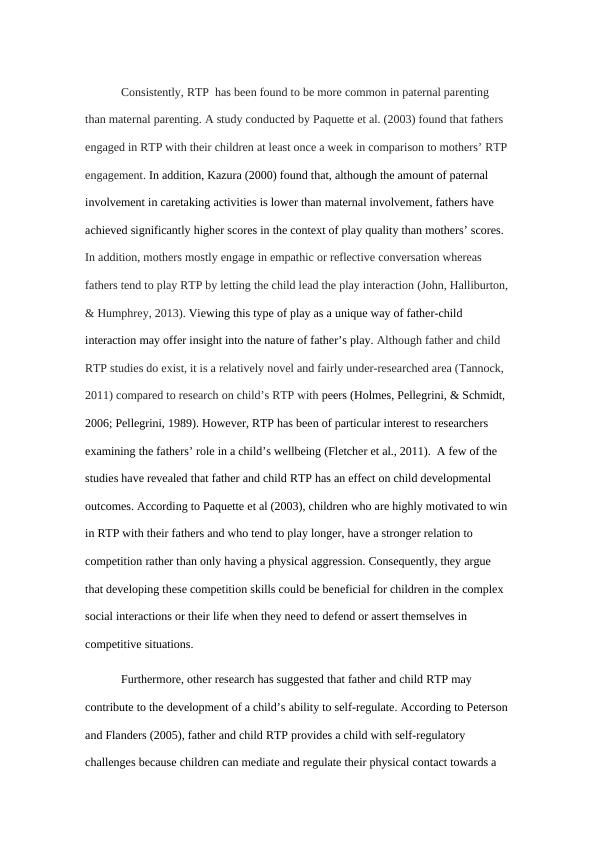
play-partner and attune their body in response to motivations and emotions of others.
This process leads to the stimulation of a child’s aggression-regulation abilities as a
consequence of RTP. Additionally, Paquette (2004) has suggested that fathers can
support the development of children's self-control through RTP by modelling
appropriate behaviour and setting limitations. These researchers have argued that RTP
may be beneficial as it may cultivate the ability to self-regulate aggressive emotions and
behaviours.
As discussed above, a significant relationship has been identified between self-
regulation and aggression and father-child RTP. Unfortunately, research into the
relationship between father-child RTP and child cognitive outcomes is scant. However,
there is research that has demonstrated that a father involvement and father play have a
positive influence on child cognitive development.
A considerable body of research exists suggesting that a father’s engagement
can have a powerful influence on child’s cognitive development. This influence has
been found in infants as young as 5 months who have a highly involved father in terms
of engagement in play and caregiving activities. These children achieve a higher score
on a cognitive measure (e.g., Bayley Scales of Infant Development) than others who
have a less involved father in such kind of activities. Additionally, father’s physical care
(e.g., feeding) and warm play (e.g., tickling) have been found to have a decreased
likelihood of a cognitive delay in reaching babbling and exploration of objects with an
aim (Bronte-Tinkew, Carrano, Horowitz, & Kinukawa, 2008), and infants who have an
involved nurturing and playful father have higher IQ as well as language performance
(Pruett, 2000).
This process leads to the stimulation of a child’s aggression-regulation abilities as a
consequence of RTP. Additionally, Paquette (2004) has suggested that fathers can
support the development of children's self-control through RTP by modelling
appropriate behaviour and setting limitations. These researchers have argued that RTP
may be beneficial as it may cultivate the ability to self-regulate aggressive emotions and
behaviours.
As discussed above, a significant relationship has been identified between self-
regulation and aggression and father-child RTP. Unfortunately, research into the
relationship between father-child RTP and child cognitive outcomes is scant. However,
there is research that has demonstrated that a father involvement and father play have a
positive influence on child cognitive development.
A considerable body of research exists suggesting that a father’s engagement
can have a powerful influence on child’s cognitive development. This influence has
been found in infants as young as 5 months who have a highly involved father in terms
of engagement in play and caregiving activities. These children achieve a higher score
on a cognitive measure (e.g., Bayley Scales of Infant Development) than others who
have a less involved father in such kind of activities. Additionally, father’s physical care
(e.g., feeding) and warm play (e.g., tickling) have been found to have a decreased
likelihood of a cognitive delay in reaching babbling and exploration of objects with an
aim (Bronte-Tinkew, Carrano, Horowitz, & Kinukawa, 2008), and infants who have an
involved nurturing and playful father have higher IQ as well as language performance
(Pruett, 2000).
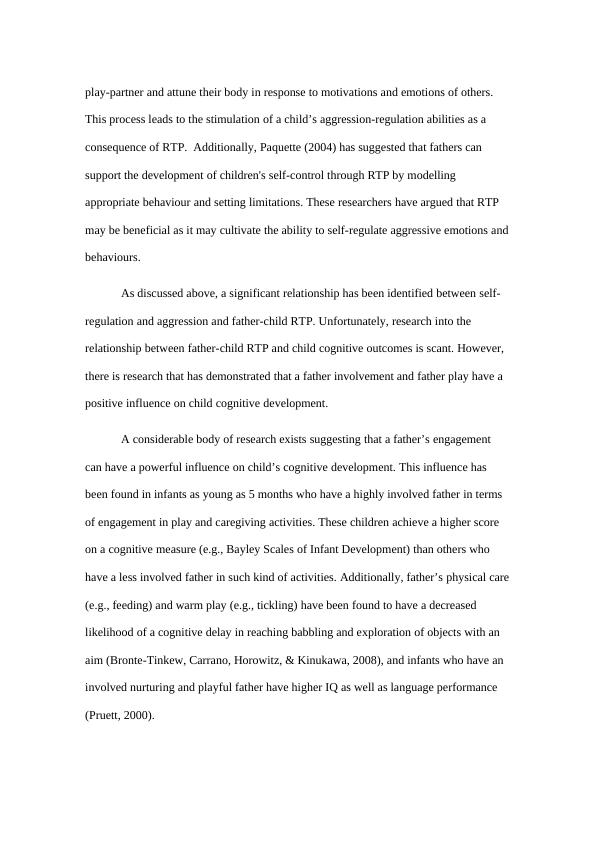
This cognitive advantage continues to positively impact children as they get
older. Yogman, Kindlan and Earls (1995) reported that children (3 years old) who have
a highly involved father, whose involvement consists of high levels of play, have a
higher IQ in comparison to children who have a less involved father. Lamb (2010)
suggests that a child's cognitive outcomes may be improved as a result of involved
fathers because a variety of stimuli resulting from interactions with both parents whose
behaviour and vocabulary differs, is seen as highly advantageous to child cognitive
outcomes. Furthermore, children with involved fathers tend to demonstrate better
competency of cognition in intelligence (Radin, 1994).
Only a few studies investigate to support the effect of father-child RTP on
cognitive developmental outcomes, there is a small body of research relating to RTP in
brain development which is related to cognition. This has been discussed by Panksepp
(1998, 2002) who notes that enjoyable RTP may help the development of the frontal
lobe for children with ADHD (Attention Deficit/Hyperactivity Disorder). These
children’s high activity level may be signalling a need for a longer period of active play
in order to facilitate the development of their frontal lobe. Given the findings of the
research focussing on the cognitive influence of father’s involvement and the role of
RTP, it can be extrapolated that the RTP a father engages in with his child may have an
influence on a range of cognitive outcomes for the child.
Measuring RTP: Quantity and Quality
A range of behaviours and elements of RTP have been measured in studies examining
RTP. These can be divided into measures of “quantity” attributes, which are commonly
the frequency of play and the duration of play, and a set of “quality” attributes, which
includes qualities or evocative characteristics of play (Stgeorge & Freeman, 2017). The
older. Yogman, Kindlan and Earls (1995) reported that children (3 years old) who have
a highly involved father, whose involvement consists of high levels of play, have a
higher IQ in comparison to children who have a less involved father. Lamb (2010)
suggests that a child's cognitive outcomes may be improved as a result of involved
fathers because a variety of stimuli resulting from interactions with both parents whose
behaviour and vocabulary differs, is seen as highly advantageous to child cognitive
outcomes. Furthermore, children with involved fathers tend to demonstrate better
competency of cognition in intelligence (Radin, 1994).
Only a few studies investigate to support the effect of father-child RTP on
cognitive developmental outcomes, there is a small body of research relating to RTP in
brain development which is related to cognition. This has been discussed by Panksepp
(1998, 2002) who notes that enjoyable RTP may help the development of the frontal
lobe for children with ADHD (Attention Deficit/Hyperactivity Disorder). These
children’s high activity level may be signalling a need for a longer period of active play
in order to facilitate the development of their frontal lobe. Given the findings of the
research focussing on the cognitive influence of father’s involvement and the role of
RTP, it can be extrapolated that the RTP a father engages in with his child may have an
influence on a range of cognitive outcomes for the child.
Measuring RTP: Quantity and Quality
A range of behaviours and elements of RTP have been measured in studies examining
RTP. These can be divided into measures of “quantity” attributes, which are commonly
the frequency of play and the duration of play, and a set of “quality” attributes, which
includes qualities or evocative characteristics of play (Stgeorge & Freeman, 2017). The
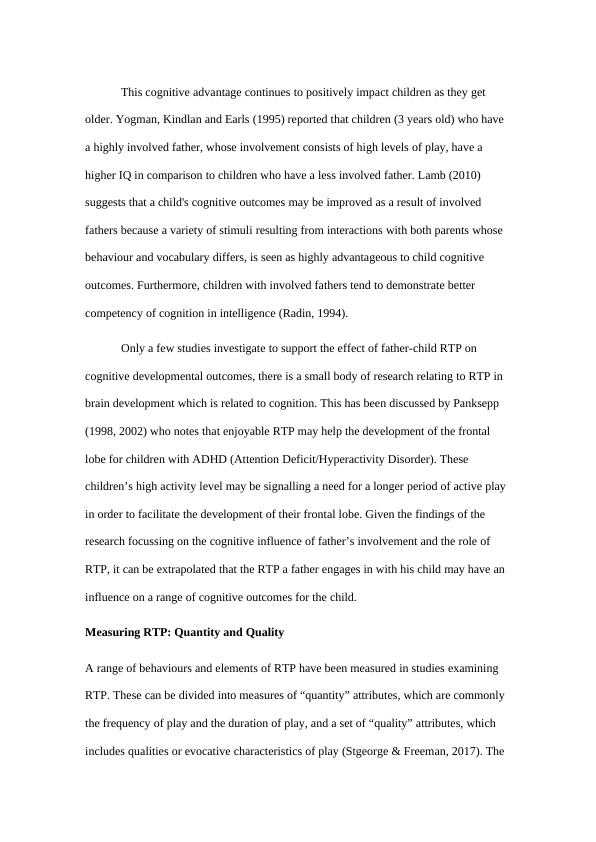
frequency RTP is the most predominantly used measurement (Fletcher, StGeorge, &
Freeman, 2013). For instance, Flanders et al., (2009) showed that the frequency of
father-child RTP is associated with the child’s aggressive behaviours and Paquette et al.,
(2003) used frequency of RTP to investigate the prevalence of father-child RTP and
child physical aggression. Frequency of RTP has sometimes been assessed by observing
the number of appearances of RTP in a given period. More often, researchers use self-
report questionnaire based on frequency Likert scales (e.g., How many times do you do
Rough and Tumble Play a week?) (Fletcher, StGeorge, & Freeman, 2013; StGeorge &
Freeman, 2017). Self-report questionnaires are advantageous as the respondents tend to
be motivated to share information about themselves and they are efficient tools to obtain
the data from a large number of participants (Paulhus & Vazire, 2007).
It is important to note, that although many researchers have used frequency in
their studies, they have recommended that in future studies, the quality of father-child
RTP should be considered (Paquette et al., 2003). Along with this, assessments of father
and child RTP should be taken into consideration as dimensions of father and child RTP
interaction which have been neglected in the research (Fletcher, StGeorge, & Freeman,
2013). Moreover, Peters, Day, Peterson, and Steinmetz (2014) argue that the
developmental psychologists have demonstrated that the quality of father and child
interactions is more clearly related to children’s development outcomes than the
quantity of involvement. Additionally, developmental psychologists have repeatedly
demonstrated that in intact father-present families, the quality of father-child
involvement is more clearly linked to children’s development outcomes than quantity of
involvement per se. In fact, if the quality is inferior or harmful (e.g., in case of an
abusive father) more father involvement can be linked to poorer developmental
outcomes for the child (Parke, 1996; Palkovitz, 1997). More involvement is sometimes
Freeman, 2013). For instance, Flanders et al., (2009) showed that the frequency of
father-child RTP is associated with the child’s aggressive behaviours and Paquette et al.,
(2003) used frequency of RTP to investigate the prevalence of father-child RTP and
child physical aggression. Frequency of RTP has sometimes been assessed by observing
the number of appearances of RTP in a given period. More often, researchers use self-
report questionnaire based on frequency Likert scales (e.g., How many times do you do
Rough and Tumble Play a week?) (Fletcher, StGeorge, & Freeman, 2013; StGeorge &
Freeman, 2017). Self-report questionnaires are advantageous as the respondents tend to
be motivated to share information about themselves and they are efficient tools to obtain
the data from a large number of participants (Paulhus & Vazire, 2007).
It is important to note, that although many researchers have used frequency in
their studies, they have recommended that in future studies, the quality of father-child
RTP should be considered (Paquette et al., 2003). Along with this, assessments of father
and child RTP should be taken into consideration as dimensions of father and child RTP
interaction which have been neglected in the research (Fletcher, StGeorge, & Freeman,
2013). Moreover, Peters, Day, Peterson, and Steinmetz (2014) argue that the
developmental psychologists have demonstrated that the quality of father and child
interactions is more clearly related to children’s development outcomes than the
quantity of involvement. Additionally, developmental psychologists have repeatedly
demonstrated that in intact father-present families, the quality of father-child
involvement is more clearly linked to children’s development outcomes than quantity of
involvement per se. In fact, if the quality is inferior or harmful (e.g., in case of an
abusive father) more father involvement can be linked to poorer developmental
outcomes for the child (Parke, 1996; Palkovitz, 1997). More involvement is sometimes
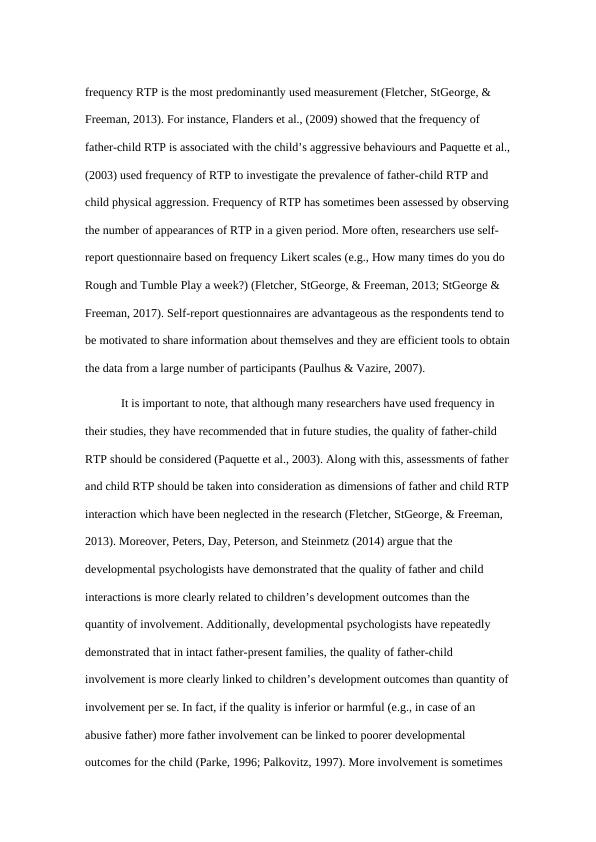
End of preview
Want to access all the pages? Upload your documents or become a member.
Related Documents
Father- Child Rough and Tumble Play (RTP)lg...
|38
|11152
|29
Child And Father Rough And Tumble Play Assignmentlg...
|12
|4193
|103
(solved) Sport Psychology Essaylg...
|10
|3375
|37
